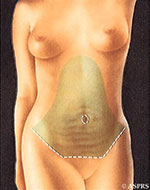Abdominoplasty (Tummy Tuck)
Am I A Candidate?
People who have loose skin and fat that is located in the abdomen can benefit from this procedure. This condition is either inherited or acquired, such as after pregnancy or substantial weight loss. Abdominoplasty can also tighten the rectus (or “six-pack”) muscles that have separated. Stretch marks or striae can also be improved, especially if they are located beneath the navel. A decision to become pregnant in the future or lose more weight, as well as previous abdominal surgery, may preclude you from this procedure.
How Is Surgery Performed?
 A curved incision is placed just above the pubic area and extended out to the hips. The amount of skin that needs to be removed dictates how long this incision will be. Dr. Lee will try to keep the incision within your bathing suit lines. If you have loose skin above the navel, another small circumferential incision may be necessary around the navel. A new opening through the skin and fat that is pulled down will have to be made for the navel. The skin and fat is lifted off of the underlying abdominal wall towards the edge of the rib cage and breast bone. The muscles are then sutured together in the middle to tighten the underlying abdominal wall. The patient is then placed in a bent or flexed position to allow for more skin and fat to be pulled down and toward the middle. The extra skin and fat are then removed. The skin that is removed may contain stretch marks that are obviously also removed. Stretch marks that remain are usually flatter and improved somewhat in appearance.
A curved incision is placed just above the pubic area and extended out to the hips. The amount of skin that needs to be removed dictates how long this incision will be. Dr. Lee will try to keep the incision within your bathing suit lines. If you have loose skin above the navel, another small circumferential incision may be necessary around the navel. A new opening through the skin and fat that is pulled down will have to be made for the navel. The skin and fat is lifted off of the underlying abdominal wall towards the edge of the rib cage and breast bone. The muscles are then sutured together in the middle to tighten the underlying abdominal wall. The patient is then placed in a bent or flexed position to allow for more skin and fat to be pulled down and toward the middle. The extra skin and fat are then removed. The skin that is removed may contain stretch marks that are obviously also removed. Stretch marks that remain are usually flatter and improved somewhat in appearance.
When the amount of excess skin and fat are concentrated beneath the navel, a partial or “mini-abdominoplasty” with a shorter incision may be all that is necessary. Liposuction may also be utilized in conjunction to improve the contour of the flank areas.
What Are The Risks?
Significant complications during a mini or full abdominoplasty procedure are rare. Some of the potential complications that will be mentioned during your consultation include bleeding, infection, and tissue loss. Revisional surgery may be required when the incision heals poorly. Although drains are placed during surgery, fluid can still build up underneath the skin and fat, occasionally requiring drainage. Diabetes and smoking also impede the healing process and increase the risk of a wound problem. You can decrease and minimize the chances of these complications by following instructions that will be given to you before and after surgery.
What Can I Expect?
Aspirin, vitamin E, and other anti-inflammatory medications can increase the amount of bleeding, so you will be asked to avoid these drugs for a few weeks before surgery, as well as after surgery. You will have to wear an abdominal binder around your waist all of the time for the first week and then as much as possible for the next 6 weeks. You will also be asked to stay in a bent or flexed position during the first week after surgery. We will ask you to get out of bed and take walks as soon as possible, but strenuous exercise and lifting should be avoided for 6 weeks. The drains remain anywhere from 1 to 4 weeks after surgery.
How Long Do The Results Last?
The swelling and bruising dissipate over the course of several weeks. The time period where you can expect stable results is usually between 1 to 3 months. You may notice areas of numbness or tingling during this period of healing.
Abdominoplasty will improve the contour of your body by achieving a flatter and firmer abdomen, allowing you to feel more confident and comfortable in your clothing. If you do not lose or gain a significant amount of weight, or become pregnant, you can expect your results to last for years to come!
